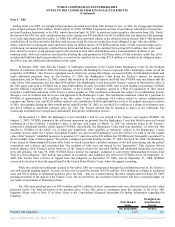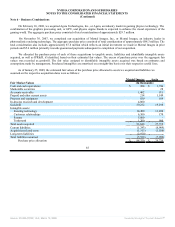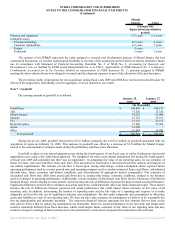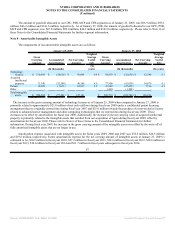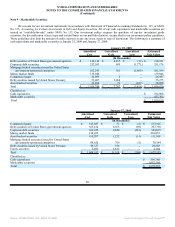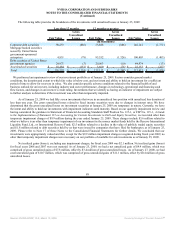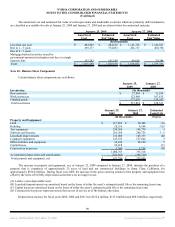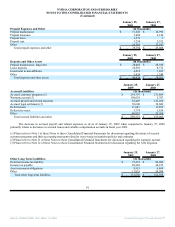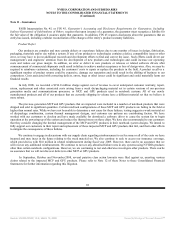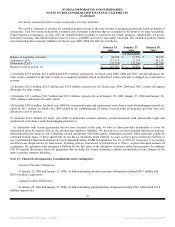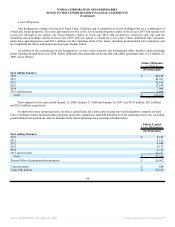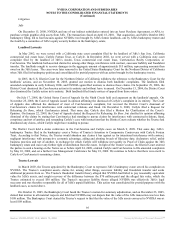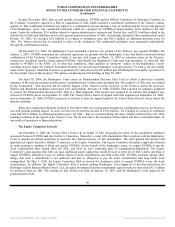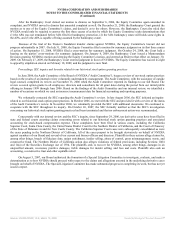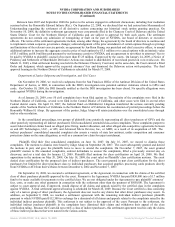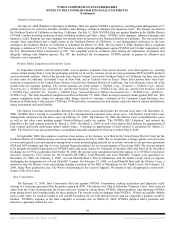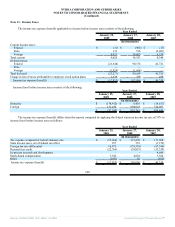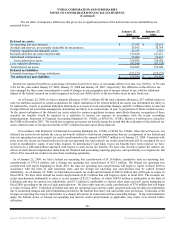NVIDIA 2009 Annual Report Download - page 110
Download and view the complete annual report
Please find page 110 of the 2009 NVIDIA annual report below. You can navigate through the pages in the report by either clicking on the pages listed below, or by using the keyword search tool below to find specific information within the annual report.
NVIDIA CORPORATION AND SUBSIDIARIES
NOTES TO THE CONSOLIDATED FINANCIAL STATEMENTS
(Continued)
Note 11 - Guarantees
FASB Interpretation No. 45, or FIN 45, Guarantor’s Accounting and Disclosure Requirements for Guarantees, Including
Indirect Guarantees of Indebtedness of Others, requires that upon issuance of a guarantee, the guarantor must recognize a liability for
the fair value of the obligation it assumes under that guarantee. In addition, FIN 45 requires disclosures about the guarantees that an
entity has issued, including a tabular reconciliation of the changes of the entity’s product warranty liabilities.
Product Defect
Our products are complex and may contain defects or experience failures due to any number of issues in design, fabrication,
packaging, materials and/or use within a system. If any of our products or technologies contains a defect, compatibility issue or other
error, we may have to invest additional research and development efforts to find and correct the issue. Such efforts could divert our
management’s and engineers’ attention from the development of new products and technologies and could increase our operating
costs and reduce our gross margin. In addition, an error or defect in new products or releases or related software drivers after
commencement of commercial shipments could result in failure to achieve market acceptance or loss of design wins. Also, we may be
required to reimburse customers, including for customers’ costs to repair or replace the products in the field. A product recall or a
significant number of product returns could be expensive, damage our reputation and could result in the shifting of business to our
competitors. Costs associated with correcting defects, errors, bugs or other issues could be significant and could materially harm our
financial results.
In July 2008, we recorded a $196.0 million charge against cost of revenue to cover anticipated customer warranty, repair,
return, replacement and other associated costs arising from a weak die/packaging material set in certain versions of our previous
generation media and communications processor, or MCP, and GPU products used in notebook systems. All of our newly
manufactured products and all of our products that are currently shipping in volume have a different material set that we believe is
more robust.
The previous generation MCP and GPU products that are impacted were included in a number of notebook products that were
shipped and sold in significant quantities. Certain notebook configurations of these MCP and GPU products are failing in the field at
higher than normal rates. While we have not been able to determine a root cause for these failures, testing suggests a weak material set
of die/package combination, system thermal management designs, and customer use patterns are contributing factors. We have
worked with our customers to develop and have made available for download a software driver to cause the system fan to begin
operation at the powering up of the system and reduce the thermal stress on these chips. We have also recommended to our customers
that they consider changing the thermal management of the MCP and GPU products in their notebook system designs. We intend to
fully support our customers in their repair and replacement of these impacted MCP and GPU products that fail, and their other efforts
to mitigate the consequences of these failures.
We continue to engage in discussions with our supply chain regarding reimbursement to us for some or all of the costs we have
incurred and may incur in the future relating to the weak material set. We also continue to seek to access our insurance coverage,
which provided us with $8.0 million in related reimbursement during fiscal year 2009. However, there can be no assurance that we
will recover any additional reimbursement. We continue to not see any abnormal failure rates in any systems using NVIDIA products
other than certain notebook configurations. However, we are continuing to test and otherwise investigate other products. There can be
no assurance that we will not discover defects in other MCP or GPU products.
In September, October and November 2008, several putative class action lawsuits were filed against us, asserting various
claims related to the impacted MCP and GPU products. Please refer to Note 12 of these Notes to these Consolidated Financial
Statements for further information regarding this litigation.
92
Source: NVIDIA CORP, 10-K, March 13, 2009 Powered by Morningstar® Document Research℠


